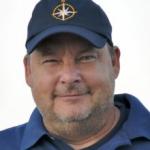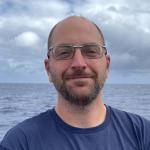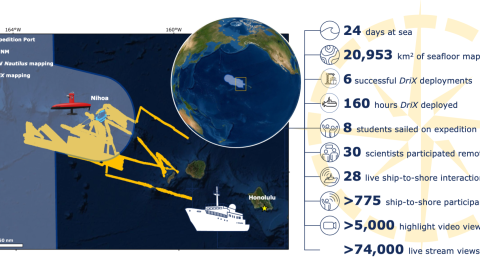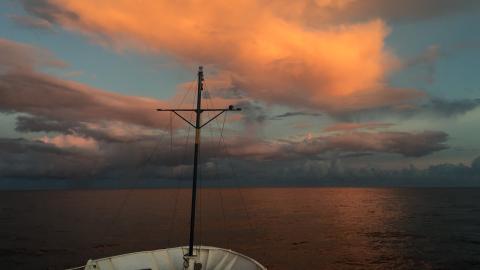This expedition focuses on high-resolution mapping areas of Papahānaumokuākea Marine National Monument (PMNM) currently lacking data using ship-based mapping surveys in deep waters as well as deploying the uncrewed surface vessel DriX for nearshore mapping. Acquiring this data will equip resource managers with a better understanding of the formation of deep-water and shallow-water terrain of the Northwestern Hawaiian Islands contribute new data to nautical charts and improve safe navigation in these areas and the national and international priority to build high-resolution maps of the seafloor, especially in areas needing protection. This expedition will focus on the southern end of PMNM, between the islands of Nihoa - Kuhikuhipuʻuone (Nihoa Island) and ʻŌnūnui, ʻŌnūiki / Pūhāhona (Gardner Pinnacles).
In deeper water, information collected during this expedition will help to identify features in the expanded PMNM boundaries and pinpoint future exploration sites for the global community. This expedition contributes to the National Ocean Mapping, Exploration, and Characterization Council (NOMEC) and GEBCO Seabed 2030 seafloor mapping priorities. Both efforts to build complete maps of the seafloor require dedicated surveying efforts, particularly in remote areas to meet these goals within the next decade. 97% of the seafloor >3000 m depth in the PMNM and Pacific Remote Islands is currently unmapped.
The expedition name Luʻu a ea a hiki i ka wawā a Palaoa was carefully crafted in concert with members of the PMNM Cultural Working Group (CWG) Nomenclature Subcommittee and team members of OET, as a continuation of the oli (chant) originated for expeditions in 2021. The chant is a reminder of the responsibility as guests working in some of the most sacred spaces for Kānaka (Native Hawaiians) during the important work to understand our ocean realm. Collaborative naming conversations led the hui (group) to examine the multiple Hawaiians terms for sounds. “Wawā” (echo, sound of distant voices) is used to honor kūpuna (ancestors) and the time spent together as we listened to the distant voices of those before us to create these names. Here “wawā,” refers also to the use of sound in drawing the map of the seafloor. The Hawaiian Language does not currently have a term for “sonar,” and mapping methods using sound. In explaining the data collection methods to Hawaiian language students, it was likened to the ability of Palaoa (Sperm Whale) who are the ultimate echolocators. “Palaoa” was selected for the upon examination of DriX and its visual similarity to a Palaoa taking a deep breath of air at the surface before a dive. Thus, “ka wawā a Palaoa,” refers to the clicking sounds a sperm whale makes to communicate and see at the depths of the ocean. Palaoa is also used in the name as a way to honor the sacred ocean spaces, its inhabitants, and Kanaloa (the ocean deity of Moananuiākea).
As we visit Papahānaumokuākea, the ancestral homeland of the Native Hawaiian people and the largest marine conservation area in the US, we gratefully acknowledge generations of indigenous Hawaiians and today’s stewards of these waters. OET is working closely with PMNM collaborators to inform research priorities at sea and from shore, ensure culturally-grounded data collection protocols, and connect with local communities through ship-to-shore connections and development of education resources in ‘Ōlelo Hawaiʻi (Hawaiian language). All of these efforts support opportunities to work with Native Hawaiians and to perpetuate the cultural values, knowledge, and practices of their cultural heritage while advancing modern science and exploration together.
This expedition is funded by NOAA Ocean Exploration via the Ocean Exploration Cooperative Institute along with the NOAA Office of Coast Survey.











































